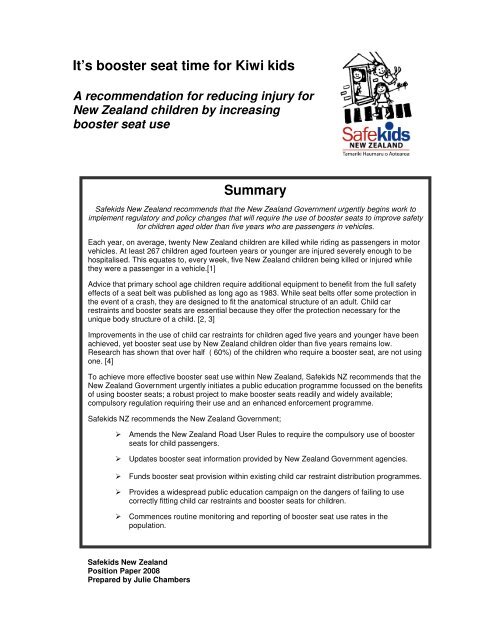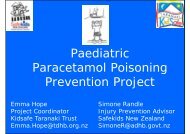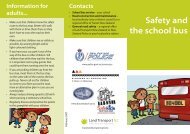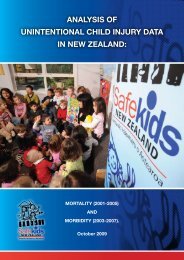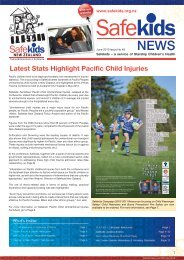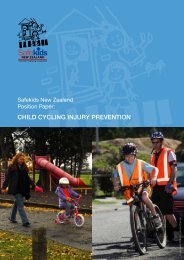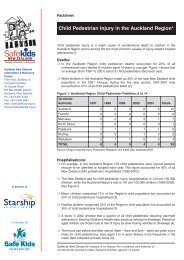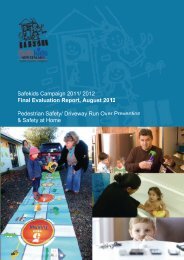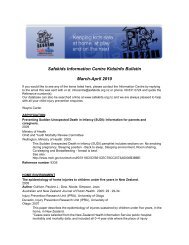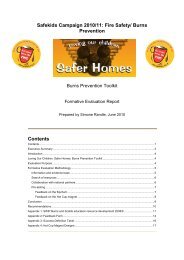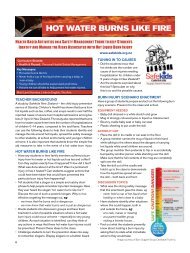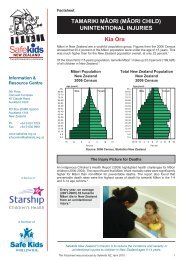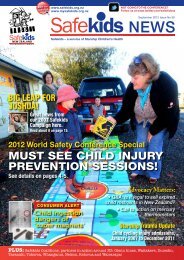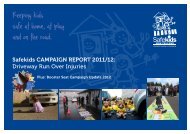Summary It's booster seat time for Kiwi kids - Safekids
Summary It's booster seat time for Kiwi kids - Safekids
Summary It's booster seat time for Kiwi kids - Safekids
Create successful ePaper yourself
Turn your PDF publications into a flip-book with our unique Google optimized e-Paper software.
It’s <strong>booster</strong> <strong>seat</strong> <strong>time</strong> <strong>for</strong> <strong>Kiwi</strong> <strong>kids</strong><br />
A recommendation <strong>for</strong> reducing injury <strong>for</strong><br />
New Zealand children by increasing<br />
<strong>booster</strong> <strong>seat</strong> use<br />
<strong>Summary</strong><br />
Safe<strong>kids</strong> New Zealand recommends that the New Zealand Government urgently begins work to<br />
implement regulatory and policy changes that will require the use of <strong>booster</strong> <strong>seat</strong>s to improve safety<br />
<strong>for</strong> children aged older than five years who are passengers in vehicles.<br />
Each year, on average, twenty New Zealand children are killed while riding as passengers in motor<br />
vehicles. At least 267 children aged fourteen years or younger are injured severely enough to be<br />
hospitalised. This equates to, every week, five New Zealand children being killed or injured while<br />
they were a passenger in a vehicle.[1]<br />
Advice that primary school age children require additional equipment to benefit from the full safety<br />
effects of a <strong>seat</strong> belt was published as long ago as 1983. While <strong>seat</strong> belts offer some protection in<br />
the event of a crash, they are designed to fit the anatomical structure of an adult. Child car<br />
restraints and <strong>booster</strong> <strong>seat</strong>s are essential because they offer the protection necessary <strong>for</strong> the<br />
unique body structure of a child. [2, 3]<br />
Improvements in the use of child car restraints <strong>for</strong> children aged five years and younger have been<br />
achieved, yet <strong>booster</strong> <strong>seat</strong> use by New Zealand children older than five years remains low.<br />
Research has shown that over half ( 60%) of the children who require a <strong>booster</strong> <strong>seat</strong>, are not using<br />
one. [4]<br />
To achieve more effective <strong>booster</strong> <strong>seat</strong> use within New Zealand, Safe<strong>kids</strong> NZ recommends that the<br />
New Zealand Government urgently initiates a public education programme focussed on the benefits<br />
of using <strong>booster</strong> <strong>seat</strong>s; a robust project to make <strong>booster</strong> <strong>seat</strong>s readily and widely available;<br />
compulsory regulation requiring their use and an enhanced en<strong>for</strong>cement programme.<br />
Safe<strong>kids</strong> NZ recommends the New Zealand Government;<br />
Amends the New Zealand Road User Rules to require the compulsory use of <strong>booster</strong><br />
<strong>seat</strong>s <strong>for</strong> child passengers.<br />
Updates <strong>booster</strong> <strong>seat</strong> in<strong>for</strong>mation provided by New Zealand Government agencies.<br />
Funds <strong>booster</strong> <strong>seat</strong> provision within existing child car restraint distribution programmes.<br />
Provides a widespread public education campaign on the dangers of failing to use<br />
correctly fitting child car restraints and <strong>booster</strong> <strong>seat</strong>s <strong>for</strong> children.<br />
Commences routine monitoring and reporting of <strong>booster</strong> <strong>seat</strong> use rates in the<br />
population.<br />
Safe<strong>kids</strong> New Zealand<br />
Position Paper 2008<br />
Prepared by Julie Chambers
Contents<br />
INTRODUCTION ..............................................................................................3<br />
IDENTIFYING THE PROBLEM........................................................................4<br />
Child passenger fatality and injury ...........................................................................................4<br />
Incorrect use of child restraints and <strong>seat</strong> belts.......................................................................4<br />
Booster <strong>seat</strong>s – little known about and under used...............................................................5<br />
THE CASE FOR BOOSTER SEATS ...............................................................5<br />
What is a <strong>booster</strong> <strong>seat</strong>? .............................................................................................................5<br />
Why should my child use a <strong>booster</strong> <strong>seat</strong> - what are their advantages? .............................6<br />
When does my child need a <strong>booster</strong> <strong>seat</strong>?.............................................................................6<br />
Why <strong>seat</strong> belts don’t fit children - and what happens in a crash..........................................7<br />
What is the safest way <strong>for</strong> my child to ride in my car? ..........................................................7<br />
WHAT ARE THE BEST WAYS TO ACHIEVE BOOSTER SEAT USE? .........8<br />
Why might so few New Zealand families use <strong>booster</strong> <strong>seat</strong>s?..............................................8<br />
Education – does it work and is it enough on its own? .........................................................8<br />
Regulation – is it the answer?...................................................................................................9<br />
BOOSTER SEAT PUBLIC POLICY ISSUES.................................................10<br />
Who would pay <strong>for</strong> the <strong>booster</strong> <strong>seat</strong>s? ..................................................................................10<br />
Are <strong>booster</strong> <strong>seat</strong> costs justified? ............................................................................................10<br />
What are the age, weight and height debates?....................................................................10<br />
CHILD CAR RESTRAINT LAW IN NEW ZEALAND .....................................11<br />
New Zealand Road User Rules ..............................................................................................11<br />
The New Zealand Road Code ................................................................................................11<br />
How are Road Rules changed?..............................................................................................12<br />
CONCLUSION ...............................................................................................12<br />
APPENDICES ................................................................................................13<br />
Appendix one: Example of child car restraint and <strong>booster</strong> <strong>seat</strong> transition criteria ..........13<br />
Appendix two: Booster <strong>seat</strong> legislation around the world...................................................13<br />
Appendix three: Booster <strong>seat</strong>s in New Zealand – Who’s Who .........................................14<br />
Appendix four: Land Transport (Road User) Rule 2004 (SR 2004/427) ..........................16<br />
REFERENCES...............................................................................................17<br />
Acknowledgement:<br />
Safe<strong>kids</strong> New Zealand acknowledges and thanks Dr Elizabeth Segedin, Dr Gabrielle<br />
Nuthall, Mr Mike Lumley and Sue Campbell <strong>for</strong> their guidance and contribution to this<br />
document<br />
Safe<strong>kids</strong> New Zealand 2008 2
Introduction<br />
Each year twenty New Zealand children are killed while they are travelling as passengers in<br />
motor vehicles. At least 267 children aged fourteen years or younger are injured severely<br />
enough to be hospitalised (on average, 1995-2004). This equates to five children killed or<br />
injured every week.[1]<br />
New Zealand’s rate of child passenger fatality ranks poorly against equivalent overseas<br />
countries including the United Kingdom, Norway and the USA (see Figure one). This indicates<br />
a huge additional toll of death and injury <strong>for</strong> New Zealand families. [5]<br />
Correctly fitting child car restraints are one of the most convincingly effective interventions <strong>for</strong><br />
the prevention of transport related injury to children. The use of car restraints <strong>for</strong> children<br />
younger than five years old has been compulsory in New Zealand since 1994.[2]<br />
Recommendation that primary school aged children also require additional equipment to<br />
benefit from the full safety effect of a <strong>seat</strong> belt was published as long ago as 1983 (twenty five<br />
years ago). While <strong>seat</strong> belts offer some protection in the event of a crash, they are designed to<br />
fit the anatomical structure of an adult. Child car restraints, including <strong>booster</strong> <strong>seat</strong>s, are<br />
essential because they offer the protection necessary <strong>for</strong> the unique body structure of a child.<br />
[2, 3]<br />
The term ‘child car restraints’ refers to the range of products which are used to provide<br />
additional protection <strong>for</strong> child passengers, these include products such as ‘baby capsules’ <strong>for</strong><br />
newborns and infants, rear facing <strong>seat</strong>s and <strong>for</strong>ward facing restraints <strong>for</strong> older children (see<br />
glossary in Appendix one). [6]<br />
Booster <strong>seat</strong>s are designed to provide protection <strong>for</strong> primary school aged children. They work<br />
in conjunction with the <strong>seat</strong> belt. Advice demonstrating that adult <strong>seat</strong> belt dimensions do not<br />
suit school aged children, and that in the event of a crash they require <strong>booster</strong> <strong>seat</strong>s <strong>for</strong><br />
adequate protection, has been known <strong>for</strong> a long <strong>time</strong>. [2, 3, 6, 7]<br />
Yet <strong>booster</strong> <strong>seat</strong> use rates in New Zealand are low. Fewer than half of the children who<br />
require a <strong>booster</strong> <strong>seat</strong> <strong>for</strong> their safety are using one. [4] A major reason <strong>booster</strong> <strong>seat</strong>s are not<br />
used is because many parents simply believe that they are not necessary, this belief is<br />
rein<strong>for</strong>ced by the fact that their use is not subject to New Zealand law.[4, 8, 9]<br />
This position paper examines the child injury issues related to <strong>booster</strong> <strong>seat</strong>s, explains why<br />
<strong>booster</strong> <strong>seat</strong> use is vital, and <strong>for</strong> whom; discusses <strong>booster</strong> <strong>seat</strong> public policy issues and<br />
presents the case <strong>for</strong> a New Zealand Road User Rule that requires the compulsory use of<br />
<strong>booster</strong> <strong>seat</strong>s, accompanied by a public education and distribution programme.<br />
Safe<strong>kids</strong> New Zealand is the national child injury prevention service based at Starship<br />
Children’s Health and is a member of Safe Kids Worldwide. Our mission is to reduce the<br />
incidence and severity of unintentional injury to children aged 0 - 14 years in New Zealand.<br />
Safe<strong>kids</strong> works to raise public awareness of child injury issues and advocates <strong>for</strong> the adoption<br />
of policies and strategies that will improve child safety.<br />
Safe<strong>kids</strong> New Zealand 2008 3
Identifying the Problem<br />
Child passenger fatality and injury<br />
Every year New Zealand has high numbers of child passenger fatalities and injuries. Correctly<br />
fitted, age appropriate child car restraints and <strong>booster</strong> <strong>seat</strong>s are the best way to reduce these<br />
statistics. Yet within New Zealand all too often these measures are not used or they are used<br />
inadequately.<br />
Each year, on average, twenty New Zealand children are killed while they are riding as<br />
passengers in motor vehicles and at least 267 children aged fourteen years or younger are<br />
injured severely enough to be hospitalised (1995-2004). [1]<br />
Car passenger fatalities contribute to 22% of all New Zealand unintentional child death. This<br />
equates to, every week, five New Zealand children killed or injured while they were travelling<br />
in a vehicle.[1]<br />
New Zealand’s child passenger fatalities rank poorly against equivalent overseas countries<br />
including the United Kingdom, Norway and the USA (see Figure one). This indicates a huge<br />
additional toll of death and injury <strong>for</strong> New Zealand families. [5]<br />
Figure One: Child passenger fatality rates compared between eight OECD countries<br />
(A) Car occupants aged 10-14 years: population-based fatality rates <strong>for</strong> a sample of Organisation <strong>for</strong><br />
Economic Cooperation and Development (OECD) countries.<br />
(B) Car occupants aged 10-14 years: population-based fatality rates expressed per unit of exposure <strong>for</strong> a<br />
sample of OECD countries.<br />
Reference; Christie, N. et al. Inj Prev 2007; 13:125-129<br />
Incorrect use of child restraints and <strong>seat</strong> belts<br />
Ensuring the correct use of child car restraints requires ongoing commitment and focus.<br />
During 2005 New Zealand’s Accident Compensation Corporation (ACC) reported that as many<br />
as 35% of New Zealand families they surveyed were using incorrectly fitted child restraints. [6]<br />
Over five years 66% of the children admitted to the Starship Hospital Paediatric Intensive Care<br />
Unit due to injuries received in a car crash were either inadequately restrained, or not<br />
restrained at all. For 33% it was not known how they were restrained; only 1% of cases were<br />
thought to be correctly restrained (2000-2004). [10]<br />
The premature and inadequate use of adult <strong>seat</strong> and lap belts to restrain children in vehicles<br />
also contributes to this injury picture. [4, 11-14]<br />
Shepherd et al reviewed children who were admitted to Starship Hospital with lap belt injures<br />
over seven years. This study described the types of injures caused by incorrectly fitting <strong>seat</strong><br />
and lap belts <strong>for</strong> 19 subjects, 16 of whom were aged between eight and fourteen years. [13]<br />
These injuries included severe head injury, spinal fractures, bowel transection, severe liver<br />
and spleen damage, and paraplegia. Overseas studies also describe similar injuries from the<br />
incorrect use of age appropriate restraints. [11, 13, 15]<br />
Safe<strong>kids</strong> New Zealand 2008 4
Booster <strong>seat</strong>s – little known about and under used<br />
Child transport experts have long been aware that <strong>booster</strong> <strong>seat</strong>s are required to provide<br />
protection <strong>for</strong> children until they are the correct proportion to fit <strong>seat</strong> belts.<br />
Research conducted in 1994 by Klinich et al <strong>for</strong> the USA National Highway Traffic Safety<br />
Administration (NHTSA), demonstrated the value of <strong>booster</strong> <strong>seat</strong>s <strong>for</strong> improving the fit of the<br />
<strong>seat</strong> belt <strong>for</strong> older children. It was found the minimum size child who should use a three point<br />
belt alone had a sitting height of 74cm, standing height of 148cm and a weight of 37 kg.[7]<br />
A later study in 2004 showed that when compared with restraint by <strong>seat</strong> belts alone, the use of<br />
a <strong>booster</strong> <strong>seat</strong> has been shown to result in 59% fewer injuries. [16]<br />
Despite this, <strong>booster</strong> <strong>seat</strong> use rates in New Zealand are low. In 2006 Cameron et al identified<br />
that as many as 60% of New Zealand children who needed a <strong>booster</strong> <strong>seat</strong> were not using one.<br />
[4]<br />
The case <strong>for</strong> <strong>booster</strong> <strong>seat</strong>s<br />
What is a <strong>booster</strong> <strong>seat</strong>?<br />
Because of their smaller size and unique proportions, children do not fit <strong>seat</strong>s and belts<br />
designed <strong>for</strong> adults. They require a <strong>booster</strong> <strong>seat</strong> to enable them to fit the <strong>seat</strong> belt correctly<br />
and gain the full safety benefit of the <strong>seat</strong> belt, in the event of a crash. Their upper legs are not<br />
long enough to sit com<strong>for</strong>tably upright with their knees bent over the edge of the <strong>seat</strong> and<br />
buttocks against the back of the <strong>seat</strong>, so they slouch backwards allowing the lap portion of the<br />
belt to ride up over the abdomen. They are also too short to sit up and reach the anchor point<br />
<strong>for</strong> the sash portion of the belt especially when slouched backwards, allowing the belt to rest<br />
over the neck. In addition their overall small size and lack of fit to the belt mechanisms allows<br />
some to be completely ejected despite a fastened belt (see Figure two). [17, 18]<br />
Figure two: Incorrect (A) and correctly fitting (B) <strong>seat</strong> belts (Source; E Segedin 2008)<br />
A<br />
Booster <strong>seat</strong>s ensure children avoid the types of injuries that can occur due to poorly fitting<br />
<strong>seat</strong> belts. [13-15, 19, 20]<br />
A <strong>booster</strong> <strong>seat</strong> is a rigid, fabric covered structure that is placed on top of a normal car <strong>seat</strong>.<br />
While there are many styles and models, it is most frequently used in conjunction with the <strong>seat</strong><br />
belt. The <strong>booster</strong> <strong>seat</strong> positions the child and guides the <strong>seat</strong> belt across the child’s thighs<br />
and hips to provide a better fit than if the child was <strong>seat</strong>ed on the <strong>seat</strong> restrained only by the<br />
car <strong>seat</strong> belt. [21]<br />
The <strong>booster</strong> raises the child higher in the car <strong>seat</strong>, so that the car’s diagonal safety belt fits<br />
properly across the child’s shoulder and breast bone, and the lap belt is positioned correctly<br />
across the top of the legs. This means that during a crash the <strong>for</strong>ces are directed through the<br />
solid bony parts of the child’s anatomy.<br />
Safe<strong>kids</strong> New Zealand 2008 5
Why should my child use a <strong>booster</strong> <strong>seat</strong> - what are their advantages?<br />
Booster <strong>seat</strong>s protect children who no longer fit child car restraints, but because of their size<br />
and physical proportions, do not receive adequate protection from using a <strong>seat</strong> belt alone.<br />
The <strong>booster</strong> <strong>seat</strong> lifts and re-positions the child within the <strong>seat</strong> belt. [6]<br />
• Children <strong>seat</strong>ed in a <strong>booster</strong> <strong>seat</strong> are much less likely to be seriously injured or killed<br />
in the event of a crash. When compared with restraint by <strong>seat</strong> belts alone, the use of<br />
a <strong>booster</strong> <strong>seat</strong> has been shown to result in 59% fewer injuries. [4, 19]<br />
• Booster <strong>seat</strong>s re-position your child in relation to the <strong>seat</strong> belt and make the <strong>seat</strong> belt<br />
more com<strong>for</strong>table <strong>for</strong> a child to use correctly. Children who are too small <strong>for</strong> an adult<br />
car <strong>seat</strong> belt wriggle <strong>for</strong>ward so that their legs are com<strong>for</strong>table, and “slouch” rather<br />
than sitting up straight. [7, 19]<br />
• Booster <strong>seat</strong>s ensure children avoid the types of injuries that occur due to incorrectly<br />
fitting <strong>seat</strong> belts. These include abdominal, head and neck injures. [7, 13-15, 20]<br />
• Some <strong>booster</strong> <strong>seat</strong>s also have ‘side wings’ that also provide lateral support and side<br />
impact protection.<br />
• Booster <strong>seat</strong>s are relatively inexpensive and simple to fit and use. In 2006 Cameron et<br />
al found that of the children who were using <strong>booster</strong> <strong>seat</strong>s in their study, 89% were<br />
using them correctly. [4]<br />
When does my child need a <strong>booster</strong> <strong>seat</strong>?<br />
As children grow taller they no longer fit their <strong>for</strong>ward facing child car restraint. While some<br />
authorities refer to age as the determining factor, there are various guides as to when children<br />
should graduate from one type of restraint to another (see Appendix one). [22] One<br />
suggestion is <strong>for</strong> a child to be graduated into the next type of <strong>seat</strong> when their head is taller<br />
than the back of their restraint. [6, 22, 23]<br />
Standardised age, height and weight charts show the majority of New Zealand children do not<br />
reach ideal dimensions <strong>for</strong> adult <strong>seat</strong> belts until they are approximately twelve to fourteen<br />
years of age. New Zealand study shows that children require the protection of a <strong>booster</strong> <strong>seat</strong><br />
when they are travelling in a vehicle:<br />
All 4 and 5 yr olds;<br />
90% of 6-8 yr olds;<br />
50% of 9 and 10 yr olds<br />
10% of 11 and 12 yr olds [4]<br />
On the basis of developmental age and height and weight normalised charts, you should<br />
assume your child may need a <strong>booster</strong> <strong>seat</strong> until they are about fourteen years of age. The<br />
“Five Step Test” is a list of questions developed to check (see Figure three). [4]<br />
Figure three: The Five Step Test<br />
Five Step Test<br />
There are five key tests that can be used to check if your child is safe just with a <strong>seat</strong> belt<br />
1. Can they sit right back in the <strong>seat</strong> without their legs sticking straight out in front of<br />
them?<br />
2. Is the diagonal part of the <strong>seat</strong> belt over their shoulder and not against their neck?<br />
3. Is the lap part of the <strong>seat</strong>belt staying low over their thighs and not riding up across<br />
their tummies?<br />
4. Are their knees bent com<strong>for</strong>tably over the edge of the <strong>seat</strong>?<br />
5. Can they stay <strong>seat</strong>ed like that <strong>for</strong> the whole trip?<br />
Safe<strong>kids</strong> New Zealand 2008 6
Why <strong>seat</strong> belts don’t fit children - and what happens in a crash<br />
Few people realize that <strong>seat</strong> belts are specifically designed <strong>for</strong> adult bodies. At least half of all<br />
children do not reach the minimum proportions required to correctly fit a <strong>seat</strong> belt until at they<br />
are at least nine years old, often older. [14, 18, 19, 23]<br />
Seat belts are designed to keep people from hitting the inside of the vehicle or being ejected in<br />
a crash. In order to hold the person in place, a <strong>seat</strong> belt must be able to disperse a great deal<br />
of <strong>for</strong>ce across, or through, the body. The belt is designed to cross over the bones of the<br />
shoulder, chest and hips. This is because these bones can absorb the energy of the crash<br />
with less injury to the child than the softer more vulnerable parts of the body. [19]<br />
When a child is too small <strong>for</strong> a <strong>seat</strong> belt, the belt rests across the wrong places, such as<br />
the child’s neck and abdomen. Children have difficulty sitting up straight in a <strong>seat</strong> belt when<br />
they are small. This is because their legs are too short to com<strong>for</strong>tably reach across the edge<br />
of the <strong>seat</strong>. They ‘slouch’ to become com<strong>for</strong>table and this causes the lap belt to rise further up<br />
the abdomen. A lap belt that starts out over the child’s hips will eventually ride up because the<br />
child’s hips are not developed sufficiently to keep the belt correctly positioned.<br />
In a crash a child sitting in this way may suffer internal injuries to their liver, kidneys, bladder,<br />
spleen and intestines. [12-15, 19]<br />
Children are also at increased risk when they tuck the shoulder belt under their arm or<br />
behind their back, or fall asleep and fall out of the sash belt. These situations are more<br />
likely to happen when the <strong>seat</strong> belt is touching the child’s neck or face.<br />
In a crash children sitting in this way are likely to ‘jack knife’ <strong>for</strong>ward – fold in half – over the<br />
lap belt. Their spinal cords may be severely injured, and their internal organs crushed and<br />
ruptured. Their heads are likely to hit the inside of the vehicle, causing head, brain or facial<br />
injuries.<br />
These risks are significantly reduced by sitting the child in a <strong>booster</strong> <strong>seat</strong>.<br />
What is the safest way <strong>for</strong> my child to ride in my car?<br />
Children are safest when <strong>seat</strong>ed in an approved, age appropriate restraint or <strong>booster</strong> <strong>seat</strong>, in<br />
a rear <strong>seat</strong> of the car. Avoid the use of lap belts only and never use a <strong>booster</strong> with a lap belt<br />
alone (see Figure four).<br />
Figure four demonstrates the way children become incorrectly positioned when they do<br />
not have a <strong>booster</strong> <strong>seat</strong>.<br />
Photos: Sunday Herald<br />
Safe<strong>kids</strong> New Zealand 2008 7
What are the best ways to achieve <strong>booster</strong> <strong>seat</strong> use?<br />
There are two main ways to increase <strong>booster</strong> <strong>seat</strong> use, through education and regulation.<br />
Promoting the correct use of age appropriate child restraints <strong>for</strong> younger children through both<br />
regulation and education has long been accepted as the way to reduce child passenger death<br />
and injury. [2, 4, 21]<br />
While they are yet to move on requiring the use of <strong>booster</strong> <strong>seat</strong>s <strong>for</strong> primary school children,<br />
or actively promoting their use, the New Zealand Government has required and en<strong>for</strong>ced the<br />
compulsory use of child restraints <strong>for</strong> children under the age of five since 1994. The<br />
government also funds an accredited training programme in child restraint use (Safe2Go),<br />
which is administered by the Child Safety Foundation. [2, 4, 24]<br />
Internationally the need <strong>for</strong> <strong>booster</strong> <strong>seat</strong>s <strong>for</strong> older children is being increasingly recognised.<br />
Legislation requiring <strong>booster</strong> <strong>seat</strong> use is being systematically implemented (in conjunction with<br />
education programmes) within, <strong>for</strong> example, the United Kingdom, the USA, Canada and the<br />
European Union. [18, 25]<br />
One direct effect of regulation (and education) is to increase the demand <strong>for</strong>, and supply of,<br />
<strong>booster</strong> <strong>seat</strong> products. This enables companies to invest in developing a greater product<br />
range and to reduce the price.<br />
Why might so few New Zealand families use <strong>booster</strong> <strong>seat</strong>s?<br />
Seat belts, harnesses and child car restraints are now accepted as a normal part of life by<br />
most New Zealanders, and their use is widespread. Booster <strong>seat</strong>s are, however, substantially<br />
less commonly used. In one study 60% of children who required a <strong>booster</strong> <strong>seat</strong> were found<br />
not to be using one. [4, 26]<br />
Many people believe that their child no longer requires a car <strong>seat</strong> after they reach the age of<br />
five. This is when the New Zealand Road Code no longer requires the compulsory use of a<br />
child restraint at all <strong>time</strong>s. The Road Code only requires children aged 5 to 14 years to use a<br />
child restraint or <strong>seat</strong> belt if one is available within the car. [23]<br />
The official Land Transport New Zealand Fact Sheet on Child Restraints, published in 2005,<br />
recommends <strong>booster</strong> <strong>seat</strong>s are only used until children are aged seven years of age. This is in<br />
contrast to other international recommendations and research that shows as many as 90% of<br />
children will still require a <strong>booster</strong> <strong>seat</strong> at this age, and older. [4, 23]<br />
In 2006 Cameron et al reported explanations from New Zealand study subjects who were not<br />
using a <strong>booster</strong> <strong>seat</strong>. These included the following statements;<br />
• Their child was “too big” <strong>for</strong> a car <strong>seat</strong> (51%)<br />
• “Don’t own one” (38%),<br />
• “Not enough room in the car” (3%),<br />
• Child resistance to using the <strong>seat</strong> (2%) and<br />
• Short trip (2%).[4]<br />
Other studies identify factors such as: the cost, child acceptance, parental misin<strong>for</strong>mation and<br />
uncertainty about when to move their child into a <strong>seat</strong> belt. Some studies identified an inverse<br />
relationship between the likelihood children would use a <strong>booster</strong> <strong>seat</strong> and the number of<br />
children in the car. Associations between parental income, the age and make of the car and<br />
the likelihood children would be using a <strong>booster</strong> <strong>seat</strong> have also been observed. Lower income<br />
families, in older model cars, were found to be less likely to use <strong>booster</strong> <strong>seat</strong>s. [8, 20, 27]<br />
Education – does it work and is it enough on its own?<br />
Community based social marketing programmes coupled with distribution projects have been<br />
shown to be effective <strong>for</strong> increasing the use of <strong>booster</strong> <strong>seat</strong>s.<br />
The systematic review of 5 studies involving over 3,070 subjects showed that education paired<br />
with distribution programmes produced more consistent results that “education only”<br />
Safe<strong>kids</strong> New Zealand 2008 8
interventions. While education only programmes provided more inconsistent results overall,<br />
more intensive education programmes are associated with more positive results. [28-31]<br />
In Canada, one study team reported that a one week national media campaign substantially<br />
increased self reported use of <strong>booster</strong> <strong>seat</strong>s. Parents did not remember all details of the<br />
campaign content, but did remember implications <strong>for</strong> their own child. This project resulted in a<br />
44% increase in <strong>booster</strong> <strong>seat</strong> use by children aged 5 to 11 years. [27, 29]<br />
A comprehensive education plan that incorporates risk communication and maximum parental<br />
participation would achieve improved results <strong>for</strong> New Zealand families. This should include<br />
three essential components;<br />
(a) Marketing to increase community understanding of the need <strong>for</strong> <strong>booster</strong> <strong>seat</strong>s.<br />
(b) Identifying the best, most effective locations <strong>for</strong> families to access expert advice<br />
about <strong>booster</strong> <strong>seat</strong>s and a range of <strong>booster</strong> <strong>seat</strong> products.<br />
(c) Making these locations well known to the public. [32]<br />
However not all groups and cohorts can respond equally to educational programmes.<br />
In the USA low socio-economic and demographic characteristics have been associated with<br />
the sub-optimal use of restraints <strong>for</strong> children. The importance of identifying poverty as a<br />
predictor of sub-optimal use of child car restraints emphasises the need <strong>for</strong> adequate <strong>booster</strong><br />
<strong>seat</strong> disbursement projects, along with education programmes and regulation. [9, 12, 33]<br />
Within New Zealand, education programmes alone, without legislation, would heighten<br />
existing disparities in health outcomes. This is because better educated, higher income<br />
families will respond more quickly to child safety messages and more easily secure improved<br />
<strong>booster</strong> <strong>seat</strong> protection <strong>for</strong> their children.<br />
Regulation – is it the answer?<br />
To achieve more effective <strong>booster</strong> <strong>seat</strong> use within New Zealand, Safe<strong>kids</strong> NZ recommends a<br />
public education programme, robust distribution and supply project combined with regulatory<br />
action and en<strong>for</strong>cement.<br />
Within communities where there is a requirement to use <strong>booster</strong> <strong>seat</strong>s <strong>for</strong> older children<br />
evidence suggests this leads to increased overall awareness of the need <strong>for</strong> adequate child<br />
restraints and compliance rates <strong>for</strong> younger children also increases. (Winston F; personal<br />
communication 2008) [34]<br />
A Monash University study identified parental uncertainty as an issue in reducing <strong>booster</strong> <strong>seat</strong><br />
use. Legislation has been shown to have a dramatically positive effect on children’s restraint<br />
wearing rates by removing parental uncertainty about when to move their child into a <strong>seat</strong>belt.<br />
[20]<br />
A Tennessee study of 1,247 children transported by 1,191 drivers assessed the recent<br />
implementation of enhanced child restraint laws in 2005. The study’s authors concluded that<br />
enhancing the law to require the use of <strong>booster</strong> <strong>seat</strong>s <strong>for</strong> the particular group of children was<br />
also effective in increasing the use of child restraints in the wider population. [33]<br />
Overseas research has also indicated that community support <strong>for</strong> <strong>booster</strong> <strong>seat</strong> legislation is<br />
possible. The majority of respondents (88%) in a Canadian study of 260 participants in a<br />
<strong>booster</strong> <strong>seat</strong> education programme said they would support a law requiring the use of <strong>booster</strong><br />
<strong>seat</strong>s until their children were ready <strong>for</strong> a <strong>seat</strong> belt. [27]<br />
There will be concerns expressed about increased costs to individual families. However a<br />
primary function of government is to mitigate costs to individuals where the imposition of those<br />
costs is justified by a demonstrable improvement <strong>for</strong> the public good. Because of their proven<br />
cost benefit outcomes, child car restraints and <strong>booster</strong> <strong>seat</strong>s fall into this category. [35]<br />
Safe<strong>kids</strong> New Zealand 2008 9
Booster <strong>seat</strong> public policy issues<br />
Motor vehicle crashes are the single largest contributor to unintentional child death and injury<br />
within New Zealand. There are high numbers of children being injured as pedestrians, cyclists<br />
and passengers. Child passenger injury contributes the highest number of hospitalisations and<br />
death. [1]<br />
It is likely that this high rate of child passenger fatality specifically contributes to New<br />
Zealand’s continued ranking as the worst of all OECD countries at protecting children from<br />
death by unintentional injury. [5, 36, 37]<br />
Who would pay <strong>for</strong> the <strong>booster</strong> <strong>seat</strong>s?<br />
A compulsory requirement <strong>for</strong> New Zealand families and organisations to purchase and install<br />
<strong>booster</strong> <strong>seat</strong>s <strong>for</strong> children will create additional costs. The policy questions <strong>for</strong> government are<br />
whether or not the costs are justifiable and where they should be allowed to fall.<br />
Are <strong>booster</strong> <strong>seat</strong> costs justified?<br />
Booster <strong>seat</strong>s, and the regulations mandating their use, have been tested in cost outcome<br />
terms and show net resource cost savings against child injury, which places them in the top<br />
tier of preventative interventions. [35]<br />
The most recent Australian study assessed child car passenger injuries to children in the four<br />
to seven year old age group. The treatment costs of injuries received from not providing<br />
<strong>booster</strong> <strong>seat</strong>s (and relying only on adult <strong>seat</strong> belts) was measured against the combined cost<br />
of creating and en<strong>for</strong>cing the regulation and the direct cost of the <strong>booster</strong> <strong>seat</strong>s. [35]<br />
The results, based on a total <strong>booster</strong> <strong>seat</strong> cost of $US 197.00, showed a return on investment<br />
of 9.4 to 1; providing a saving of $US 1,854.00 per <strong>seat</strong>. Even lower bound estimates in<br />
sensitivity analysis indicated a social benefit. Booster <strong>seat</strong> laws alone are shown to offer a<br />
return of 8.6 to 1.[35]<br />
This provides an extremely strong case <strong>for</strong> regulation. The New Zealand Government has a<br />
wide range of policy options available and can provide a range of strategic interventions to<br />
mitigate costs to families and organisations.<br />
What are the age, weight and height debates?<br />
The only major research into <strong>seat</strong> belt and <strong>booster</strong> <strong>seat</strong> fit was carried out by Klinich et al, <strong>for</strong><br />
the NHTSA in 1994. This research found the minimum size child who should use a three point<br />
belt alone had a sitting height of 74cm, standing height of 148cm and a weight of 37 kg. [7]<br />
These recommendations however, have not been carried <strong>for</strong>ward to all traffic jurisdictions and<br />
age, weight and height recommendations <strong>for</strong> the use of <strong>booster</strong> <strong>seat</strong>s differ. [22, 30, 33, 38,<br />
39]<br />
For example the US National Highway Safety Administration and European safety agencies<br />
recommend that children weighing more than 20 kg should use belt positioning <strong>booster</strong> <strong>seat</strong>s<br />
until they are at least eight years old or 1.40 m tall (4ft 9 in). United Kingdom governments<br />
have legislated <strong>for</strong> compulsory <strong>booster</strong> <strong>seat</strong> use until children are 138 cms tall or twelve years<br />
of age and British Columbia at 145cm and at least 9 years (see Appendix two). [18]<br />
These differences reflect governments trading off between child safety and the perceived<br />
receptiveness of their populations, cost, and the age and quality of the available car fleet.<br />
However almost all agree and emphasise that height is the most important feature of <strong>seat</strong> belt<br />
fit. [20]<br />
Decisions about the provision of <strong>booster</strong> <strong>seat</strong>s <strong>for</strong> New Zealand children in relation to their<br />
age, height, and weight can be resolved through Land Transport Authority’s (Land Transport<br />
New Zealand) policy development and consultative processes.<br />
Safe<strong>kids</strong> New Zealand 2008 10
Given the overwhelming evidence <strong>for</strong> <strong>booster</strong> <strong>seat</strong> effectiveness in reducing child death and<br />
injury, this process will also be an effective way to facilitate more effective community<br />
awareness and help existing collaborative partnerships find agreement.<br />
Child car restraint law in New Zealand<br />
Drivers in New Zealand are responsible to ensure all children younger than five years old are<br />
properly restrained by an approved child restraint. Children of this age must not travel in the<br />
car if they cannot be secured into an approved child restraint. Older children must only use a<br />
<strong>seat</strong> belt or restraint if one is available. [40]<br />
There are a number of agencies involved in child transport safety. These are listed, with a<br />
brief description of their functions, in Appendix three.<br />
New Zealand Road User Rules<br />
The Land Transport Act (1998) empowers the Minister of Transport to make Road User Rules.<br />
These Rules enable specific traffic requirements to be created without requiring a full<br />
Parliamentary vote. Road Rules are a simplified legislative process to enable efficient<br />
response to urgent road traffic issues, such as safety. Like regulations, they have legal power<br />
and can be en<strong>for</strong>ced by the police. [40]<br />
Land Transport New Zealand produces Rules under an agreement made with the Secretary<br />
<strong>for</strong> Transport. The Responsible Minister seeks the agreement of Cabinet be<strong>for</strong>e drafting<br />
commences and refers the Rule to Cabinet <strong>for</strong> noting be<strong>for</strong>e signing it into law. Road User<br />
Rules are en<strong>for</strong>ced by the NZ Police and subject to penalties. [40]<br />
Road Rules were introduced as a more simple legislative mechanism to full legislative<br />
changes.<br />
Current Road User Rules related to child car restraints are quoted in Appendix four.<br />
The New Zealand Road Code<br />
The New Zealand Road Code is a published, user friendly compilation of the statutory<br />
requirements (Road User Rules) relating to vehicle use within New Zealand. It is not a<br />
statutory document and includes notes and illustrations to provide safety advice and promote<br />
understanding of Road User Rules.<br />
In short, the Road Code paraphrases the statutory requirements <strong>for</strong> child restraint use in New<br />
Zealand (Road User Rules 7.4 – 7.10) [40].<br />
The NZ Road Code states child car restraint use must be as follows,<br />
• All children under five years of age must be in an approved child restraint when they<br />
are travelling in a car or a van. An adult safety belt is not considered suitable.<br />
• Children between five and seven years old must use an approved child restraint if one<br />
is available. Otherwise they must use an adult <strong>seat</strong> belt. If there is no safety belt<br />
available, the child must be in the back <strong>seat</strong>.<br />
• Older children (older than seven) must use an adult safety belt. If there is no safety<br />
belt available, the child must be in the back <strong>seat</strong>. [6]<br />
• Within the New Zealand Road Code the term an ‘approved child restraint’ refers to a<br />
child restraint that complies with at least one of three standards – AS / NZ 1754, USA<br />
standard FMVSS 213, or European Standard ECE44.<br />
• The restraint must be suitable <strong>for</strong> the age, weight, height and physical development of<br />
the child. [6]<br />
Safe<strong>kids</strong> New Zealand 2008 11
The 2006 edition directs readers to the Safe2Go programme web site <strong>for</strong> additional<br />
in<strong>for</strong>mation on the availability and correct use of child car restraints. See www.Safe2Go.co.nz<br />
How are Road Rules changed?<br />
Safe<strong>kids</strong> strongly urges Government to urgently schedule <strong>booster</strong> <strong>seat</strong> policy development<br />
work during the 2008/2009 financial year. There are five stages to the development of New<br />
Zealand Road User Rules.<br />
Blue phase: policy development, which may include a discussion paper on policy<br />
proposals.<br />
Red phase (optional): Draft of the legislative provisions sent to registered interest<br />
groups.<br />
Yellow phase: Public consultation (advertised in public notice columns of the major<br />
metropolitan and regional newspapers and distributed widely).<br />
Green (optional): Draft of Rule released <strong>for</strong> final comment if there’s a long delay or<br />
major changes after the yellow draft was released.<br />
White phase: This is the draft which is sent to the Ministry of Transport <strong>for</strong> government<br />
scrutiny. The Ministry and other departments and agencies may make changes be<strong>for</strong>e<br />
the Rule is submitted to Cabinet and then to the Minister to sign. They are then tabled<br />
in Parliament.<br />
The commencement of Ministry of Transport <strong>booster</strong> <strong>seat</strong> policy work would enable key<br />
stakeholder consultation to begin immediately with wider public education beginning in earnest<br />
in 2009. A Road Rule change could then be implemented during that year.<br />
Conclusion<br />
The use of correctly fitting child car restraints is one of the most convincingly effective<br />
interventions <strong>for</strong> the prevention of transport related injury to children. New Zealand<br />
Government advice that adult <strong>seat</strong> belt dimensions do not suit primary school children and<br />
recommending that older children are also provided with the additional protection of a <strong>booster</strong><br />
<strong>seat</strong> was published as long ago as 1983. [3]<br />
Yet <strong>booster</strong> <strong>seat</strong> use rates in New Zealand are low. A major reason <strong>booster</strong> <strong>seat</strong>s are not<br />
used is most likely because parents think their children have outgrown the need <strong>for</strong> special car<br />
<strong>seat</strong>s and that <strong>booster</strong> <strong>seat</strong>s are not necessary. [4] Government regulation and advice plays a<br />
role in this misconception. [23, 41]<br />
To achieve more effective <strong>booster</strong> <strong>seat</strong> use within New Zealand, Safe<strong>kids</strong> NZ recommends<br />
the urgent implementation of a public education programme, funding to ensure <strong>booster</strong> <strong>seat</strong>s<br />
are available in the same way (and through the same agencies) that currently distribute child<br />
restraints and implements compulsory <strong>booster</strong> <strong>seat</strong> use through a Road Rule change,<br />
supported by appropriate en<strong>for</strong>cement.<br />
Safe<strong>kids</strong> NZ recommends the New Zealand Government;<br />
Amends the New Zealand Road User Rules to require the compulsory use of<br />
<strong>booster</strong> <strong>seat</strong>s <strong>for</strong> child passengers.<br />
Updates <strong>booster</strong> <strong>seat</strong> in<strong>for</strong>mation provided by New Zealand Government<br />
agencies.<br />
Funds <strong>booster</strong> <strong>seat</strong> provision within existing child car restraint distribution<br />
programmes.<br />
Provides a widespread public education campaign on the dangers of failing to use<br />
correctly fitting child car restraints and <strong>booster</strong> <strong>seat</strong>s <strong>for</strong> children.<br />
Commences routine monitoring and reporting of <strong>booster</strong> <strong>seat</strong> use rates in the<br />
population.<br />
Given the overwhelming evidence <strong>for</strong> <strong>booster</strong> <strong>seat</strong> effectiveness in reducing child death and<br />
injury, doing nothing is not an option.<br />
Safe<strong>kids</strong> New Zealand 2008 12
Appendices<br />
Appendix one: Example of child car restraint and <strong>booster</strong> <strong>seat</strong> transition criteria<br />
Product Size Range Transition Criteria Age Criteria<br />
Rearward facing<br />
Zero to nine months<br />
capsule<br />
Forward facing<br />
child <strong>seat</strong><br />
Booster<br />
Until child too<br />
long <strong>for</strong><br />
capsule (70<br />
cen<strong>time</strong>tres)<br />
Eight –<br />
eighteen<br />
kilograms<br />
Eighteen<br />
kilograms plus<br />
eye level above<br />
back of<br />
restraint or<br />
shoulders too<br />
wide<br />
Adult <strong>seat</strong> belt Height > 145<br />
cen<strong>time</strong>tres<br />
(and meet belt<br />
fit guidelines)<br />
Baby is too long to fit in capsule<br />
or weighs more than nine to<br />
twelve kilograms. If using rearfacing<br />
convertible restraint, keep<br />
rear facing as long as possible<br />
(up to twelve months).<br />
Child’s eye level is above the top<br />
of the back of the child <strong>seat</strong>,<br />
shoulders are above the top set<br />
of shoulder strap slots or when<br />
child weighs more than eighteen<br />
kilograms.<br />
When the child can achieve a<br />
good <strong>seat</strong> belt fit without the<br />
<strong>booster</strong> i.e. child’s legs are long<br />
enough to have their back firmly<br />
against the <strong>seat</strong>, and their legs<br />
bent in front of the <strong>seat</strong> cushion.<br />
This ensures the <strong>seat</strong> belt fits<br />
across the hip bones, and not<br />
over the soft abdomen. Usually,<br />
this is about 145 cen<strong>time</strong>tres tall<br />
and the sash (shoulder strap)<br />
passes across the centre of the<br />
shoulder, NOT across the<br />
bottom or side of the neck<br />
Nine months – four<br />
years<br />
Five years – at least<br />
eight years<br />
Australian Road Rules 7 th Amendment Package 2007; Prince of Wales Medical Research<br />
Institute.<br />
Appendix two: Booster <strong>seat</strong> legislation around the world<br />
Many countries have legislated <strong>for</strong> <strong>booster</strong> <strong>seat</strong> use to ensure older children are more<br />
effectively protected in the event of a car crash.<br />
Australia: Regulations <strong>for</strong> restraint of children have been reviewed; changes approved by the<br />
Federal Government and are to be implemented by each State. Once implemented, children<br />
will need to be in a dedicated child <strong>seat</strong> or infant restraint (each with a built-in harness) up to<br />
four years of age and a <strong>booster</strong> <strong>seat</strong> will be required up to seven years of age. As part of this<br />
package the Australian Standards <strong>for</strong> child restraints are being revised to cater <strong>for</strong> older,<br />
larger children in <strong>booster</strong> <strong>seat</strong>s [20].<br />
Britain: Since September 2006 United Kingdom Governments have required the compulsory<br />
use of <strong>booster</strong> <strong>seat</strong>s <strong>for</strong> children aged over five and younger than twelve years. The Actual<br />
wording is 135cm or twelfth birthday whichever comes first, but the British RoSPA website <strong>for</strong><br />
parents suggests “…it is better to keep them in the <strong>booster</strong> <strong>seat</strong> or cushion until they have<br />
reached 150cm tall”.<br />
Canada: Transport Canada publishes national child restraint recommendations which include<br />
advice <strong>for</strong> families to use <strong>booster</strong> <strong>seat</strong>s from 18kg (40lb) generally from age four and a half to<br />
eight years. Canadian Provinces have individual traffic jurisdictions and many have begun<br />
Safe<strong>kids</strong> New Zealand 2008 13
investigations into implementing <strong>booster</strong> <strong>seat</strong> regulation. At the beginning of 2008, five<br />
Provinces had mandatory requirements <strong>for</strong> <strong>booster</strong> <strong>seat</strong>s in place. The most recent was<br />
enacted in British Columbia effective 1 July 2008 mandating <strong>booster</strong> use <strong>for</strong> under at least 9<br />
years or 145cm tall. (BCAA Traffic Safety Foundation)<br />
(www.child<strong>seat</strong>center.com/article11html - accessed Feb. 2008)<br />
European Union: The European Parliament has made a mandatory rule that children less<br />
than 150 cm in height occupying vehicles fitted with safety systems must be restrained by an<br />
integral or non-integral child restraint system suitable <strong>for</strong> the child's mass between zero and<br />
36 kg (up to 79 lb). However, until 9 May 2008 Member States could permit the use of child<br />
restraint systems approved in accordance with their national standards.<br />
USA: At the beginning of 2008, eleven American States have legislation requiring <strong>booster</strong><br />
<strong>seat</strong>s be used <strong>for</strong> children over the age of five. State requirements vary as to the age and size<br />
of the child requiring <strong>booster</strong> <strong>seat</strong>s (see section 3.4). However the National Highway Safety<br />
Authority (NHTSA) recommends that children who have outgrown child safety <strong>seat</strong>s, are less<br />
than 8 years old, and are less than 4'9" tall should be in <strong>booster</strong> <strong>seat</strong>s.<br />
Appendix three: Booster <strong>seat</strong>s in New Zealand – Who’s Who<br />
While the use of child car restraints <strong>for</strong> infants and children younger than five has increased<br />
over the past ten years, there are still many New Zealand children who are completely<br />
unrestrained, restrained by ill fitting and insecure child restraints, or using adult <strong>seat</strong> belts<br />
be<strong>for</strong>e they provide an adequate fit [6].<br />
The following organisations work to improve the numbers of children correctly restrained.<br />
Each of these organisations would be directly involved in a programme to require children to<br />
use <strong>booster</strong> <strong>seat</strong>s.<br />
Safe2Go<br />
Safe2Go is a national child car restraint training programme jointly funded by the Accident<br />
Compensation Corporation and Land Transport New Zealand.<br />
The programme is administered by the Child Safety Foundation, who provides certified<br />
training sessions on the correct installation and use of child car restraints.<br />
Advised by a multi agency Steering Group, the programme also acts as an expert reference<br />
group, publishes a regular newsletter and maintains a contact list of people who are trained to<br />
provide advice in the correct use of car restraints. There are approximately seven Safe2Go<br />
trainers nationally.<br />
The Safe2Go website address www.safe2go.co.nz is included as a reference within the New<br />
Zealand Road Code publication 2006.<br />
The Accident Compensation Corporation (ACC)<br />
The Accident Compensation Corporation (ACC) is the Crown entity responsible <strong>for</strong><br />
administering New Zealand’s accident compensation scheme, advising government, and<br />
providing injury prevention services to people within New Zealand.<br />
In 2005/06, ACC spent about $41 million on injury prevention programmes in collaboration<br />
with employers, community groups, sporting bodies and others. It is also responsible <strong>for</strong><br />
collecting injury cover levies and ensuring individuals who qualify receive accident cover, case<br />
management, medical and other care and rehabilitation services (ACC Fact Sheet, accessed<br />
2008).<br />
The prevention of injury to children while they are car occupants is an integral part of this role.<br />
In this capacity it supports the Safe2Go programme and sits on the Steering Group.<br />
Safe<strong>kids</strong> New Zealand 2008 14
Land Transport New Zealand (New Zealand Transport Agency; as at August 2008)<br />
Land Transport New Zealand (Land Transport NZ) was a Crown entity promoting land<br />
transport sustainability and safety, allocating government funding <strong>for</strong> land transport. The<br />
organisation, governed by a board of directors appointed by the Minister of Transport, was<br />
established under the Land Transport Management Amendment Act 2004.<br />
In August 2008 Land Transport New Zealand will combine with Transit New Zealand under<br />
enacted legislation. The new body is the New Zealand Transport Agency (NZTA).<br />
The government's New Zealand Transport Strategy (NZTS) provides the framework within<br />
which transport policy is developed. Land Transport NZ is responsible <strong>for</strong> contributing to the<br />
five objectives of the New Zealand Transport Strategy: assisting economic development,<br />
assisting safety and personal security, improving access, and mobility ensuring environmental<br />
sustainability and protecting and promoting public health.<br />
The NZTA holds expertise in child car restraint technology and will be involved in the<br />
development of a Booster <strong>seat</strong> Road Rule. The NZ Transport Agency also holds a position on<br />
the Safe2Go Steering Group.<br />
Advice from NZTA on <strong>booster</strong> <strong>seat</strong>s is inadequate see Fact Sheet Number 7 from 2003. [42]<br />
The NZTA also provides published advice on its web site (accessed May 2008) which does<br />
not mention height or the preference <strong>for</strong> <strong>booster</strong> <strong>seat</strong>s as protection in the event of a crash.<br />
The Ministry of Transport<br />
As the government's principal Transport Policy Adviser, the Ministry of Transport is central to<br />
the development of a new <strong>booster</strong> <strong>seat</strong> Road Rule.<br />
In this policy advisory role, the Ministry of Transport provides policy advice to the Minister,<br />
including providing advice on the making of Transport (Road) Rules. Working in collaboration<br />
with other Transport Crown entities, the Ministry of Transport is also responsible <strong>for</strong> contract<br />
management; air services agreements; development of legislation and Vote Transport<br />
administration.<br />
Plunket<br />
As a nation-wide community based health provider, Plunket supports key national child and<br />
family health goals established by the New Zealand Ministry of Health (1998) and provides a<br />
wide range of services and activities.<br />
Among its key roles are Plunket’s commitments to address the health disparities between New<br />
Zealand children and reduce death rates, injury and disability from unintentional injury.<br />
Plunket has a strong child health advocacy role through its Littlies Lobby (a collaboration<br />
between Plunket and the Office of the Children’s Commissioner), and Every Child Counts<br />
(Every Child Counts is a coalition <strong>for</strong>med by Barnardos, Plunket, UNICEF, Save the Children,<br />
and the Institute of Public Policy at the Auckland University of Technology).<br />
The Child Safety Foundation<br />
The activities of the Child Safety Foundation are aimed, principally, but not exclusively at the<br />
safety of those children under the age of seven years. Foundation ef<strong>for</strong>ts are aimed at parent,<br />
caregiver, pre-school and primary school groups.<br />
The Foundation acts as a lobby group who are able to consider, initiate and support by- laws,<br />
codes and improvements in the laws calculated to promote child safety.<br />
The Child Safety Foundation operates the Safe2Go child car restraint programme.<br />
Safe<strong>kids</strong> New Zealand 2008 15
Safe<strong>kids</strong> New Zealand<br />
Safe<strong>kids</strong> NZ is the national injury prevention service of Starship Children’s Health and a<br />
member of Safe Kids Worldwide. Safe<strong>kids</strong> mission is to reduce the incidence and severity of<br />
unintentional injury to children aged 0 - 14 years in New Zealand.<br />
Safe<strong>kids</strong> works to raise public awareness of child injury issues and advocates <strong>for</strong> the adoption<br />
of policies and strategies that will improve child safety.<br />
Appendix four: Land Transport (Road User) Rule 2004 (SR 2004/427)<br />
Section on child car restraints…<br />
7.6 Driver must ensure passengers under 5 years use child restraint. A driver must ensure<br />
that, while the vehicle is in motion on a road, every passenger under the age of 5 years is<br />
properly restrained by an approved child restraint appropriate <strong>for</strong> that passenger.<br />
7.7 Driver must ensure passengers of or over 5 years but under 8 years use child restraint or<br />
<strong>seat</strong> belt. A driver must ensure that, while the motor vehicle is in motion on a road, every<br />
passenger of or over the age of 5 years but under the age of 8 years—<br />
(a) is properly restrained by an approved child restraint appropriate <strong>for</strong> that<br />
passenger, if such a restraint is available in the vehicle; or<br />
(b) if such a restraint is not available in the vehicle, is restrained as securely as<br />
practicable in the circumstances using any child restraint or <strong>seat</strong> belt that is available<br />
(whether or not that child restraint or <strong>seat</strong> belt is approved).<br />
7.8 Driver must ensure passengers of or over 8 years but under 15 years wear <strong>seat</strong> belts<br />
A driver must ensure that, while the motor vehicle is in motion on a road, passengers of or<br />
over the age of 8 years but under the age of 15 years occupying a <strong>seat</strong> that is fitted with a<br />
<strong>seat</strong> belt (whether that <strong>seat</strong> belt is an approved <strong>seat</strong> belt or not) wears the <strong>seat</strong> belt and keeps<br />
it securely fastened.<br />
7.9 Driver must not permit passengers under 15 years to sit in front <strong>seat</strong> without child restraint<br />
or <strong>seat</strong> belt. A driver must not, while the motor vehicle is in motion on a road, permit a<br />
passenger under the age of 15 years who is not properly restrained by an approved child<br />
restraint or <strong>seat</strong> belt appropriate <strong>for</strong> that passenger to be alongside the driver unless—<br />
(a) the vehicle is not provided with sitting positions behind the driver's <strong>seat</strong>; or<br />
(b) all the sitting positions behind the driver's <strong>seat</strong> are occupied by passengers under<br />
the age of 15 years.<br />
7.10 Persons of or over 15 years must wear <strong>seat</strong> belt and keep it fastened. A person of or<br />
over the age of 15 years who is in a motor vehicle in motion on a road and who is occupying a<br />
<strong>seat</strong> that is fitted with a <strong>seat</strong> belt (whether that <strong>seat</strong> belt is an approved <strong>seat</strong> belt or not) must<br />
wear the <strong>seat</strong> belt and must ensure that it is securely fastened.<br />
7.11 Exceptions to application of requirements relating to use of child restraints and <strong>seat</strong> belts<br />
(1) The requirements of clauses 7.7 to 7.10 do not apply to a driver (whether imposed<br />
in respect of himself or herself or any child), or to a passenger in any motor vehicle, if<br />
the driver or passenger produces to an en<strong>for</strong>cement officer, whenever required to do<br />
so by that officer, a certificate from a registered medical practitioner certifying that the<br />
restraining of the person who would otherwise be required by those provisions to be<br />
restrained by a child restraint or <strong>seat</strong> belt is impracticable or undesirable <strong>for</strong> medical<br />
reasons.<br />
(2) A driver or passenger who seeks to rely on subclause (1) must, if so required by<br />
an en<strong>for</strong>cement officer, produce the certificate to an en<strong>for</strong>cement officer within 7 days<br />
after having been so required.<br />
(3) The requirements of clauses 7.7 to 7.10 do not apply to a driver (whether imposed<br />
in respect of himself or herself or any child), or to a passenger in any vehicle, if the<br />
person who would otherwise be required by those provisions to be restrained by a<br />
child restraint or <strong>seat</strong> belt—<br />
Safe<strong>kids</strong> New Zealand 2008 16
(a) is the driver and, while complying with the requirements of those clauses,<br />
could not reasonably operate effectively any of the following items of<br />
equipment:<br />
(i) footbrake or handbrake controls:<br />
(ii) headlamp or foglamp:<br />
(iii) direction-indicator control:<br />
(iv) horn:<br />
(v) windscreen-wiper control:<br />
(vi) choke:<br />
(vii) driver's sun visor; or<br />
(b) is the driver of a vehicle that is travelling in reverse, and would not be able<br />
to reverse the vehicle in a safe manner if the driver were to comply with the<br />
requirements of those clauses; or<br />
(c) is the driver of a taxi plying <strong>for</strong> hire; or<br />
(d) is a person who—<br />
(i) is engaged in the course of his or her employment in the delivery<br />
or collection of mail or newspapers or other goods, or the servicing of<br />
the vehicle, or meter reading or other similar duties, or spraying or<br />
other similar duties from the vehicle; and<br />
(ii) <strong>for</strong> that purpose is required to alight from and re-enter the vehicle<br />
at frequent intervals, so long as the vehicle is travelling at a speed not<br />
exceeding 50 km per hour; or<br />
(e) is an en<strong>for</strong>cement officer or prison officer travelling with another person<br />
who is not an en<strong>for</strong>cement officer or prison officer in circumstances in which it<br />
is impracticable or undesirable to wear a <strong>seat</strong> belt.<br />
(4) The requirements of clauses 7.7, 7.8, and 7.10 do not apply to a driver (whether<br />
imposed in respect of himself or herself or any child), or to a passenger in any vehicle,<br />
if the person who would otherwise be required by those provisions to be restrained by<br />
a child restraint or <strong>seat</strong> belt is the driver of a bus.<br />
(5) The requirements of clause 7.6 do not apply to a driver (whether imposed in<br />
respect of himself or herself or any child), or to a passenger in any vehicle, if the<br />
driver—<br />
(a) is driving a passenger service vehicle in which no appropriate child<br />
restraints are available; or<br />
(b) is driving a goods vehicle having an unladen weight exceeding 2 000 kg in<br />
which no <strong>seat</strong> belts are available; or<br />
(c) is driving a motor vehicle first registered be<strong>for</strong>e 1 January 1955 in which<br />
no <strong>seat</strong> belts are available; or<br />
(d) is driving a motorcycle; or<br />
(e) is driving a motor vehicle that is being used by an en<strong>for</strong>cement officer in<br />
the execution of the officer's duty.<br />
References<br />
1. IPRU, Injury Prevention Research Unit; National Injury Query System<br />
(NIQS), in Otago University. 2008.<br />
2. Simpson J, et al., Examining child restraint use and barriers to their use:<br />
lessons from a pilot study. Injury Prevention, 2003. 9: p. 326-331.<br />
3. Appleton I, Young children and adult <strong>seat</strong> belts; Is it a good idea to put<br />
children in adult <strong>seat</strong> belts?, in Traffic Research Report 31. 1983:<br />
Wellington.<br />
Safe<strong>kids</strong> New Zealand 2008 17
4. Cameron L, et al., Safe restraint of the child passenger. Journal of<br />
Paediatrics and Child Health, 2006. 42: p. 752-757.<br />
5. Christie N, et al., How exposure in<strong>for</strong>mation can enhance our<br />
understanding of traffic 'death leagues'. Injury Prevention, 2007. 13: p.<br />
125-129.<br />
6. Fredrickson B, Sitting Safely? Child Restraints Report. Consumer, 2006.<br />
461(August): p. 24-27.<br />
7. Klinich, K. and H. Pritz, Study of Older Child Restraint/Booster Seat Fit<br />
and NASS Injury Analysis. National Highway Traffic Safety<br />
Administration, 1994. Vehicle Research and Test Centre(East Liberty<br />
OH).<br />
8. Howard A, Snowdon A, and Macarthur C, Removing barriers to <strong>booster</strong><br />
<strong>seat</strong> use in Canada. Paediatrics and Child Health, 2004. 9(Number 5).<br />
9. Winston F, et al., Parent characteristics associated with sub-optimal<br />
restraint of child passengers. Traffic Injury Prevention, 2006. 7(4): p. 373-<br />
380.<br />
10. Nuthall G, Starship Hospital Intensive Care Database, in unpublished data,<br />
ADHB, Editor. 2008.<br />
11. Byard R and Noblett H, Child <strong>booster</strong> <strong>seat</strong>s and lethal <strong>seat</strong> belt injury.<br />
Journal Paediatrics and Child Health, 2004. 40: p. 639-641.<br />
12. Krahn D, et al., Children as Passengers in Motor Vehicle Crashes. Injury<br />
Bulletin. Vol. No 96. 2007: Queensland Injury Surveillance Unit.<br />
13. Shepherd M, Hamill J, and Segedin L, Paediatric lap-belt injury: a 7 year<br />
experience. Paediatric Emergency Medicine, 2006. 18: p. 57-63.<br />
14. Winston F, et al., The Danger of Premature Graduation to Seat Belts <strong>for</strong><br />
Young Children. Pediatrics, 2000. 105(6): p. 1179 - 1183.<br />
15. Kortchinsky T, et al., Misuse of an adult <strong>seat</strong> belt in a 7 year old child: A<br />
source of dramatic injuries and a plea <strong>for</strong> <strong>booster</strong> <strong>seat</strong> use. Pediatric<br />
Emergency Care, 2008. 24(3): p. 161 - 163.<br />
16. Aborgast K, Kallan M, and Durbin D, Effectiveness of high back and<br />
backless belt positioning <strong>booster</strong> <strong>seat</strong>s in side impact crashes. Annu Proc Ass<br />
Adv Automot Med., 2005. 49: p. 201-213.<br />
17. US Department of Transportation, A parent's guide to buying and using<br />
<strong>booster</strong> <strong>seat</strong>s. 2005: National Highway Traffic Safety Administration.<br />
Safe<strong>kids</strong> New Zealand 2008 18
18. National Highway Traffic Safety Administration, A parent's guide to<br />
buying and using <strong>booster</strong> <strong>seat</strong>s, in US Department of Transportation. 2005.<br />
19. Safe<strong>kids</strong> Canada, Booster Seat Use in Canada: A National Challenge. 2004.<br />
20. Koppel S, et al., Factors associated with the premature graduation of<br />
children into <strong>seat</strong>belts. Accident Analysis & Prevention, 2008. 40: p. 657-<br />
666.<br />
21. Durbin D R, M., MSCE, , Elliot MR PhD, and Winston F K MD PhD,<br />
Belt-Positioning Booster Seats and Reduction in Risk of Injury Among<br />
Children in Vehicle Crashes. Journal American Medical Association, 2003.<br />
289(21): p. 2835 - 2840.<br />
22. National Transport Commission, Australian Road Rules 7th Amendment<br />
Package 2007; Regulatory Impact Assessment. 2007: Melbourne.<br />
23. Land Transport New Zealand, Fact Sheet 7 - Child Restraints. 2005: New<br />
Zealand.<br />
24. Safe2Go, http://www.safe2go.co.nz/. accessed 2008.<br />
25. Durban D, et al., Effects of <strong>seat</strong>ing position and appropriate restraint use on<br />
the risk of injury to children in motor vehicles. Pediatrics, 2005. 115: p. 305-<br />
309.<br />
26. New Zealand Government Ministry of Transport Child restraint survey:<br />
Results of national survey, December 2007, N.Z. Government, Editor. 2007.<br />
27. Howard A, et al., Evaluation of Safe Kids Week 2004: Age 4 to 9? <strong>It's</strong><br />
<strong>booster</strong> <strong>seat</strong> <strong>time</strong>! Injury Prevention, 2006. 12: p. 316-319.<br />
28. Snowdon A, et al., Effectiveness of a mul<strong>time</strong>dia intervention on parents'<br />
knowledge and use of vehicle safety systems <strong>for</strong> children. Journal of<br />
Paediatric Nursing, 2008. 23: p. 126-139.<br />
29. Towner E, et al., What works in preventing unintentional injuries in<br />
children and young adolescents? An updated systematic review, D.o.C.H.<br />
Community Child Health, Editor. 2004, Health Development Agency;<br />
University of Newcastle upon Tyne: UK,.<br />
30. Turner C, et al., Community-based programs to promote car restraints in<br />
children 0 - 16 years - a systematic review. Accident Analysis & Prevention,<br />
2005. 37: p. 77-83.<br />
Safe<strong>kids</strong> New Zealand 2008 19
31. Turner C, et al., Community-based programs to promote car restraints in<br />
children 0 - 16 years - a systematic review. Accident Analysis & Prevention,<br />
2005(37): p. 77-83.<br />
32. Will K and Geller E, Increasing the safety of children's vehicle travel: From<br />
effective risk communicaton to behaviour change. Journal of Safety<br />
Research, 2004. 35: p. 263-274.<br />
33. Gunn V, Phillippi R, and Cooper W, Improvement in <strong>booster</strong> <strong>seat</strong> use in<br />
Tennessee. PEDIATRICS, 2007. 119(1).<br />
34. Winston F, Booster <strong>seat</strong> use increases use of child restraints, overall, J.<br />
Chambers, Editor. 2008.<br />
35. Miller T, Zaloshnja E, and Hendrie D, Cost-outcome analysis of <strong>booster</strong><br />
<strong>seat</strong>s <strong>for</strong> auto occupants aged 4 to 7 years. Pediatrics, 2006. 118(5): p. 1994-<br />
1998.<br />
36. UNICEF Innocenti Research Centre, A league table of child deaths by<br />
injury in rich nations, in Report Card No 2. 2001: Florence, Italy.<br />
37. UNICEF Innocenti Research Centre, Child poverty in perspective; an<br />
overview of child well-being in rich countries; A comprehensive assessment<br />
of the lives and well-being of children and adolescents in the economically<br />
advanced nations, in Report Card No 7. 2007: Florence, Italy.<br />
38. Ehiri J, et al., Interventions to increase children's <strong>booster</strong> <strong>seat</strong> use; A review.<br />
American Journal of Preventive Medicine, 2006. 31(2).<br />
39. Winston F, et al., Effect of <strong>booster</strong> <strong>seat</strong> laws on appropriate restraint use by<br />
children 4 to 7 years old involved in crashes. Archives Pediatr Adolesc<br />
Med., 2007. 161: p. 270-275.<br />
40. New Zealand Government, Land Transport (Road User) Rule, in (SR<br />
2004/427). 2004.<br />
41. Land Transport New Zealand, The New Zealand Road Code. 2007,<br />
Wellington: Land Transport New Zealand.<br />
42. Land Transport New Zealand, Fact Sheet 7 - Child Restraints. 2003: New<br />
Zealand.<br />
Safe<strong>kids</strong> New Zealand 2008 20


